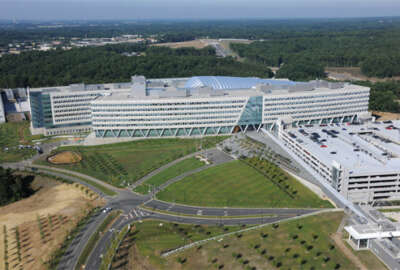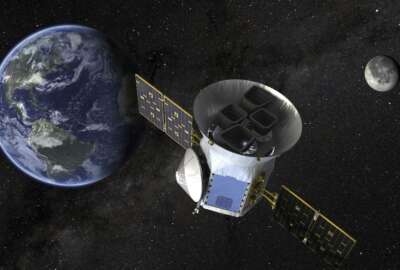
NGA looks to stay ahead of sheer volume of satellite imagery data
National Geospatial-Intelligence Agency Director Robert Cardillo said satellite imagery has improved exponentially since he joined the government in the 1980s.
Best listening experience is on Chrome, Firefox or Safari. Subscribe to Federal Drive’s daily audio interviews on Apple Podcasts or PodcastOne.
When it comes to getting the big picture on security threats around the world, the intelligence community has come a long way since the Cold War.
National Geospatial-Intelligence Agency Director Robert Cardillo, speaking Thursday at the George T. Kalaris Intelligence Conference at Georgetown University, said satellite imagery has improved exponentially since he joined the government in the 1980s.
“Literally, you would put film in this satellite, and bless the wizards who came up with this, the satellite would fly in space. It would expose that imagery through a lens. It would then complete the roll of film, and I kid you not, it would eject it out of the satellite. It would then come back through the atmosphere. It would deploy a parachute, and it would be caught by a plane with a trapeze on the back of it. Sounds nutty,” Cardillo said. “And I think it sounds amazing.”
But in recent years, private-sector companies have entered the space race, and into a marketplace that government use to have a monopoly over.
Cardillo said some of the tech produced in government labs, like the internet and GPS, have helped the private sector reach into space.
“That discovery, all the wizardry that I referenced, then became available to academics, to commercial companies, to public institutions, to apply other benefits from that access to space. And so yes, the barriers to space are dropping, because you can now achieve access to space, not in an easy way, but easier than it was before, and now it’s created great commercial opportunities.”
In the past 10 years or so, commercial companies have had the capability to launch their own satellites into space. But in the last two-or-three years, Cardillo said the commercialization of space has increased exponentially.
One company NGA does business with, DigitalGlobe, currently has five satellites in orbit. Another partner, Planet Labs, now has more than 150 satellites.
Cardillo said those extra satellites give NGA a strategic advantage.
“If I can contract with a company like DigitalGlobe, that we have now for eight years, or with Planet Labs — we’re doing our third contract with them — to give me more access over more areas of the planet … that’s all to my advantage.”
Over time, Cardillo said NGA has relied more on commercial solutions to meet the unclassified parts of its mission.
“All the maps, all the safety of air navigation responsibilities we have are predominantly derived from that commercial source. Two reasons for that. One, it’s available at a cost that the government believes it’s a good use of taxpayer dollars and two, because the source is unclassified from the beginning, and I need to hand you a map that you need to take into that cockpit or onto that bridge, that’s unclassified. You can imagine that’s a simpler, more straightforward process.
NGA has made a big push to recruit recent graduates with in-demand STEM skills, but Cardillo said the agency still welcomes a variety of talent.
“The more that we’ve invested in data science, and computer science, and computer visioning of late, some people believe that we don’t need liberal arts majors anymore. Nothing could be further from the truth, because remember our ultimate value proposition is advantage. We can’t derive that advantage unless we intellectually curious, analytically driven, methodologically sound analysts.”
Cardillo added that NGA’s workforce of about 14,000 employees will be empowered by advances in data science. But he added that there’s just no replacing human analysts.
“Yes, our business is to know the earth, but our business is really to understand human intention, and the only way you get at that is when you use humans to infer future activity of other humans. It’s an innately human activity. So yes, we’re pushing hard, we’re recruiting hard our data science component, and our skillset on our staff, but we have not let up to ensure that we have the right number, the right balance of those people that can drive that data science to help us understand that human intent.”
However, the human workforce does need help getting a handle on the sheer volume of data that’s produced. Planet Labs, the company with 150 satellites, takes 1.5 million satellite pictures a day. Since those satellites launched, they’ve taken a total of 730 million pictures.
“In my era, if an image arrived at our agency, either a human exploited it, or it didn’t get exploited,” Cardillo said. “It went into the library, and you might go get it later, but it had to have eyes, through a microscope, onto a table, and somebody had to write something down saying, ‘This is what I saw.’ We can’t keep up that way with that kind of volume.”
At a recent geo-intelligence conference, NGA crunched the numbers and found that it would need 6 million imagery analysts to keep up that flow of information. But since NGA can’t do that, Cardillo said the agency is trying to leverage technology to get most out of its current workforce.
Latest Technology News
More recently … he said technology has gotten better at detecting what wasn’t in an image yesterday that’s now new — simple objects like buildings, roads, railroads and vehicles.
“As the computer gets better at that, it can help us to understand where there are changes in not just from day to day, but in what we call patterns of life — hostile threat, adversarial capability that we seek to understand, employment of a missile system. It isn’t just about that missile, it’s about everything that’s around it. … What the computer can is help us filter, detect the change, and cue the human — that’s my expert, that’s that intellectually curious, analytically driven person to the right point in time, so that they can employ the grey matter and answer the really important question, what does it mean?”
But NGA data doesn’t just stay in the intelligence community. NGA data contributes to natural disaster recovery, and in medical emergencies, like an outbreak of Ebola in Africa. And the past month, the agency released a new map of Antarctica that’s publicly available online.
“We’re able now to contribute a baseline understanding of a place that had very little scientific understanding,” Cardillo said.
But amid a rise of artificial tools, Cardillo said the agency spends more time checking the quality of the data it receives.
“It has become more difficult to have coherent, connected conversations about the veracity of information, the pedigree of the information. Those good old days in 1983 [where] if you were my customer and we’re in a top-secret room, and I hand you a picture, there’s no question about where it came from — who handled it, who controlled it, etc,” Cardillo said. “We spend a lot more time now on that, because as much as I am appreciative of these commercial companies that we contract with, I then have to make sure it was handled properly. We do spend a lot of time on this, and we will spend more.
Copyright © 2024 Federal News Network. All rights reserved. This website is not intended for users located within the European Economic Area.
Jory Heckman is a reporter at Federal News Network covering U.S. Postal Service, IRS, big data and technology issues.
Follow @jheckmanWFED




